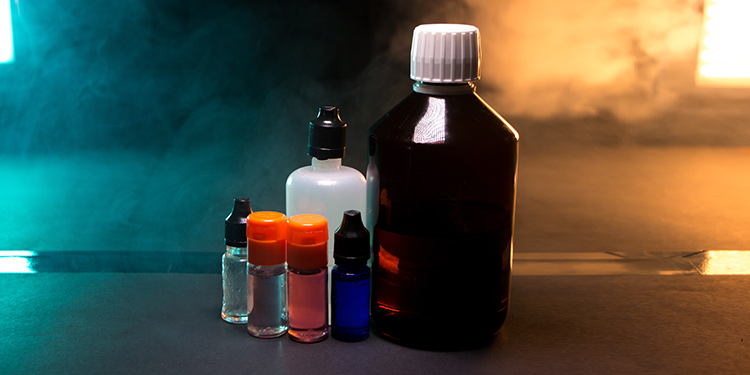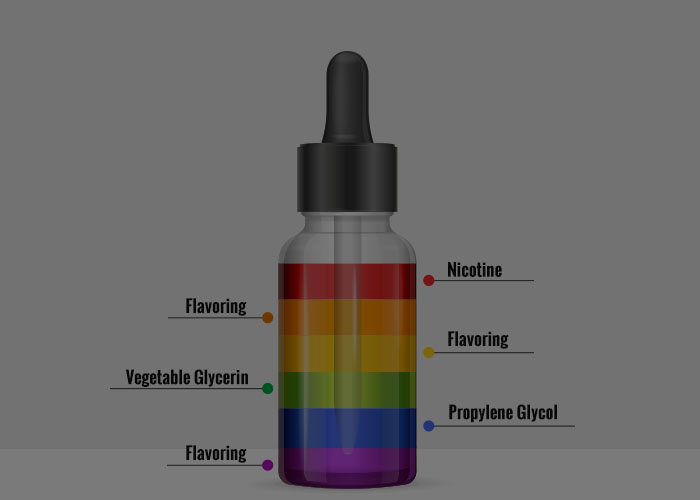Despite so many media outlets demonising eliquids in general, people need to be aware of what actually is in your bottle of juice.

Most negative reports and articles on the subject tend to be in direct reference to the ‘nicotine’ content within the eliquids, but this is not largely reported as such. As with anything, to much of a particular thing is bad, you drink too much water, it is bad, you run to much, you damage your joints etc, so it needs to be put in the context of the individual.
Fortunately, and if any eliquid creator is legitimate and fully certified, then there is no dark secret about how e-juice is made or what goes into it. All ingredients are almost always (and should be) listed on the label. That’s the law in the EU and the UK with certain warning patches required also.
Discovering what is in the liquid is one thing, but how informative is it? Most of it is chemical names, which can look intensely scientific generally don’t say a lot about what the substances actually are. or do. That makes it easy for people and media entities to generate often falsities about eliquids, such as they contain ‘antifreeze’. Obviously any major companies, again whom are fully certified, would never do this. The rare instances where reports are heard to have suffered ill effects, and indeed issues to related to the ingestion of ‘antifreeze’ has come from non-registered companies or from home made juices. So frankly, buyer beware if you intend to source your eliquids from such creators.
Most eliquids have four main ingredients and here is what you can expect to be fulling up your tank or atomiser.

Vegetable glycerin
Liquid designed for modern atomisers is mostly vegetable glycerin, or VG – this can be up to 80% by volume. If you want to know how it is that e-cigs have gone from producing a little wisp of thin vapour to belching out huge white plumes, this is why.
Glycerin is a natural substance that can be processed from most kinds of fat. The glycerine used in e-liquid comes from vegetable oils, which is why it’s called VG, but it doesn’t really make a lot of difference. One important point is that although it’s processed from oils it isn’t an oil. In fact it’s an alcohol, which makes it safe to inhale.
VG is a non-toxic colourless liquid with no smell, but a sweet taste. It’s very thick and viscous, which means high-VG liquids don’t work well in older atomisers and small clearomisers – it’s too thick to wick well. Some liquids use aqueous glycerine to solve this, basically just VG with some water added.
Lots of common products contain VG. It’s used in the food industry as a sweetener, and also added to some foods to keep them moist. Many medicines contain it too. Scientists have studied it for years, and it’s never been linked to any health problems.
Liquids with a lot of VG produce lots of dense vapour, but not a lot of throat hit.
Propylene glycol
Most of what isn’t VG in your liquid is probably propylene glycol, or PG. Some liquids contain more PG than VG; these work better in clearomisers and older atomisers, because they’re less viscous.
PG is an alcohol, like VG, and it’s also nearly odourless. It has a faint sweet taste, although not enough for it to be used as a sweetener; it does get added to foods, medicines and other products to keep them moist, though.
One other use for PG is in antifreeze, and it’s because of this that some people like to claim e-juice contains antifreeze. In fact this is totally dishonest. PG is only one ingredient in antifreeze, and it’s actually there because it’s non-toxic; PG-based antifreeze is less harmful to children and pets. It’s worth pointing out that water is also an ingredient in antifreeze; just because something is used in a product that has a reputation for being poisonous, that doesn’t say anything about how harmful that substance is.
It’s true that there have been some minor health issues linked to PG. It’s been studied since the 1940s and is classed as generally safe; swallowing or inhaling it won’t do you any harm. A small percentage of people are sensitive to it, though, so if liquid with a high PG content makes you feel unwell, switch to one with more VG.
PG produces less visible vapour than VG, so it’s unpopular with cloud chasers but liked by people who want to vape discreetly. It also carries flavours better and gives more throat hit.
Flavourings
One of the best things about vaping is the wide choice of delicious-tasting juices, and that’s all down to flavourings. Liquid doesn’t have much taste on its own, so it’s flavoured with food-grade additives.
If there are any health concerns about vaping that’s mostly down to flavourings. There are some ingredients that are safe to eat but not to inhale – diacetyl, for example. However, the industry has done well at eliminating additives that there are worries about. Don’t use food flavourings from the supermarket though; some of them contain oils, which are harmful if inhaled. Stick to flavours from vape manufacturers, because these have been elected for maximum inhalation safety.
Nicotine
Finally, most liquids contain nicotine. This is what makes vaping such an effective substitute for smoking; you can satisfy your nicotine cravings without having to set fire to tobacco leaves. Nicotine also gives a good throat hit, so if this is important to you try higher-nicotine liquids.
Although it gets a lot of bad publicity, nicotine is actually a very safe drug: It’s the smoke from cigarettes that causes harm, not the nicotine. It is toxic in high does, but there’s really no chance of poisoning yourself by vaping. Long before you get to a dangerous level it will make you feel slightly nauseous, then give you a headache. Vapers (and smokers) are very good at getting just as much nicotine as they need, and no more.
It’s usually best to avoid e-liquids that contain anything apart from these four ingredients. Vitamins, colouring, supplements like caffeine – these don’t do anything for the quality of your vape, and unlike flavourings they haven’t been selected for inhalation safety. But if you stick to the ingredients listed here you can look forward to a low-risk and enjoyable vaping experience

Vvapour have been established as one of the vape industries longest running providers of quality eliqiuds, merchandise and information since 2011, and trading since 2012. We can help anyone from seasoned vapers, to those starting out and wanting to kick the habit of traditional smoking. The company CEO created Vvapour primarily to help people stop smoking following the death of a close, rather than as a profit building business. Get in touch for any information and advice o anything vape related. Either email us on:
info@vvapour.co.uk
or call us on:
0121 794 2043
or you can also live chat us on the website (lower left chat box icon)
between 9am and 5pm.
www.vvapour.co.uk
vapelyfe coilporn ukvapescene picoftheday vapeporn photo vape vapecommunity vapepics instagram vapelife vapefam vapemodels ejuice igdaily vapegear vapestagram eliquid instadaily girlswhovape colourful photography cloudchasing ukvapers vapeon subohm calivapers movievapes vapersuk dripgirls vape vapeporn vapelife vapecommunity vapefam vapestagram vapeon vaping instavape vapor subohm vapedaily ejuice vapenation cloudchaser eliquid calivapers vapehooligans coilporn ecig vapepics clouds vapelove notblowingsmoke dripclub cloudchasing girlswhovape vaperexpo tricklyfe cloudlyfe vape vaper vapour vgod vaping vapelife selfie vapestagram vapelyfe vapecommunity vapefam vapeon vapetricks instavape ukvapers vapeuk vapepics vapevids tricks vgodtricklyfe officialvapetricks teamcoolsmoketricks combustionisdead sosk teamhotwiresuk vgodtricks teamhotwires
